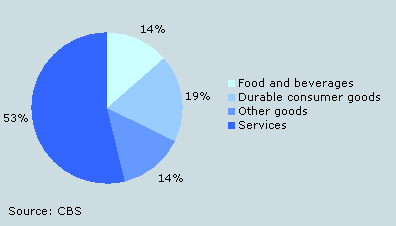Short-term statistics on retail trade and consumption by households

Statistics Netherlands measures spending by households in its monthly statistics on consumption expenditure. Part of this expenditure takes place in retail outlets. In its monthly statistics on retail trade, Statistics Netherlands monitors sales by various retail sectors. Both statistics therefore give a picture of spending by households: one from the point of view of the consumer, the other from the point of view of the seller. The monthly statistics on retail trade are also an important source for the monthly statistics on consumption expenditure. They are not the only source, however: consumers spend most of their money on other providers of goods and services. This article looks at both series of statistics, their common ground, and their differences.
Retail statistics focus on sales
Every month, Statistics Netherlands asks a large percentage of retail companies for their turnover figures. The companies are classified by retail sector on the basis of their main activity. The boundaries between the sectors have become less sharp in recent years, as supermarkets now often also sell computers, and tobacconists sell magazines, lottery tickets and bus tickets. Retail shops are divided into the food sector (supermarkets and specialist shops such as bakers, butchers and greengrocers) and non-food (other shops). In addition, there are retailers without shops, such as stallholders, and Internet and mail order companies.
The monthly statistics on retail trade measure where sales take place. What is sold and to whom is not relevant for these statistics. As most retail goods are sold to consumers, the development in retail turnover gives a first indication of the development of spending by households on goods. From the point of view of developments in the economy, sales of electronics, furniture, clothes and shoes are the most interesting. These so-called durable goods are most sensitive to developments in the economy.
More than half of consumption expenditure on services
The statistics on consumption expenditure by households cover a wider area than spending on retail alone. More than half of consumer spending is for services, such as rent, telephone, medical care and public transport.
Division of domestic consumption expenditure, 2005

About three-quarters of spending on goods is spent in retail outlets. Many products can be purchased in more than one place. Flowers, for example, can be bought from a florist, a garden centre, supermarket or a market stall. The focus of statistics on consumption expenditure is on what consumers buy, not where they buy it.
Retail turnover is an important, but not the only, source of information for consumption expenditure on goods by households. Supply of gas and electricity, for example, is organised through energy companies. Turnover of petrol stations and garages is not measured in the monthly statistics on retail trade, but in other short-term statistics of Statistics Netherlands. Turnover of dispensing chemists is also not included in the retail statistics. The monthly statistics on consumption expenditure are compiled in accordance with guidelines and definitions of the National Accounts. These accounts give a systematic and consistent description of the Dutch economy. Consumption by households is an important component of the expenditure side of the economy. On the basis of a wide range of information, estimates are made of total consumption by households. The first estimates are based on still provisional information, each subsequent estimate uses more definite information. In contrast to the results of the statistics on retail trade, the consumption statistics are systematically confronted with the results of other statistics in the National Accounts, among other things, statistics on imports, exports and production. The consumption estimate can then be adjusted on the grounds of this comparison. In addition to differences in content between the two series of statistics, there is also a difference in how the results are reported. For the retail trade sectors the accent is usually on the change in the value of their turnover. For monthly figures on consumption expenditure, the focus is on changes in volume. In the calculation of the latter, corrections are applied for changes in the value of consumption caused by higher or lower prices and differences in shopping day patterns. Statistics on retail turnover and consumption expenditure by households both give an indication of spending by households. The turnover statistics approach this from the seller’s point of view, the expenditure statistics from the consumer’s point of view. Another substantial difference is that the monthly statistics on consumption expenditure measure all spending by consumers, while the monthly retail trade statistics only reflect part of the sales by companies to consumers. Consumption expenditure by households is therefore estimated on the basis of several sources. One of these sources is the monthly statistics on retail trade. Within the National Accounts, the consumption statistics are systematically confronted with the outcomes of other statistics. Finally, reports on the results of both monthly statistics are compiled from a different perspective.Consumption in accordance with National Accounts
Accents in reports
Summary